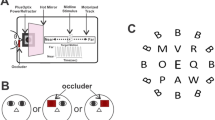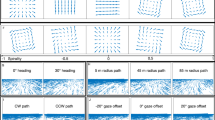Abstract
An observer moving forwards through the environment experiences a radial pattern of image motion on each retina. Such patterns of optic flow are a potential source of information about the observer's rate of progress1, direction of heading2 and time to reach objects that lie ahead3. As the viewing distance changes there must be changes in the vergence angle between the two eyes so that both foveas remain aligned on the object of interest in the scene ahead. Here we show that radial optic flow can elicit appropriately directed (horizontal) vergence eye movements with ultra-short latencies (roughly 80 ms) in human subjects. Centrifugal flow, signalling forwards motion, increases the vergence angle, whereas centripetal flow decreases the vergence angle. These vergence eye movements are still evident when the observer's view of the flow pattern is restricted to the temporal hemifield of one eye, indicating that these responses do not result from anisotropies in motion processing but from a mechanism that senses the radial pattern of flow. We hypothesize that flow-induced vergence is but one of a family of rapid ocular reflexes, mediated by the medial superior temporal cortex, compensating for translational disturbance of the observer.
This is a preview of subscription content, access via your institution
Access options
Subscribe to this journal
Receive 51 print issues and online access
$199.00 per year
only $3.90 per issue
Buy this article
- Purchase on Springer Link
- Instant access to full article PDF
Prices may be subject to local taxes which are calculated during checkout



Similar content being viewed by others
References
Prokop, T., Schubert, M. & Berger, W. Visual influence on human locomotion: Modulation to changes in optic flow. Exp. Brain Res. 114, 63–70 (1997).
Warren, W. H. & Hannon, D. J. Direction of self-motion is perceived from optical flow. Nature 336, 162–163 (1988).
Lee, D. N. Atheory of visual control of braking based on information about time-to-collision. Perception 5, 437–459 (1976).
Cornilleau-Pérès, V. & Gielen, C. C. A. M. Interactions between self-motion and depth perception in the processing of optic flow. Trends Neurosci. 19, 196–202 (1996).
Lee, D. N. The optic flow field: the foundation of vision. Phil. Trans. R. Soc. Lond. B290, 169–179 (1980).
Collewijn, H. & Erkelens, C. J. in Eye Movements and their Role in Visual and Cognitive Processes (ed. Kowler, E.) 213–261 (Elsevier, Amsterdam, (1990)).
Erkelens, C. J. & Regan, D. Human ocular vergence movements induced by changing size and disparity. J. Physiol. (Lond) 379, 145–169.(1986).
Cohen, G. A. & Lisberger, S. G. Motion disparity and looming cues form hierarchical inputs for smooth pursuit of targets moving in 3 dimensions. Soc. Neurosci. Abstr. 22, 964 (1996).
Enright, J. T. Art and the oculomotor system: perspective illustrations evoke vergence changes. Perception 16, 731–746 (1987).
Takeuchi, T. Visual search of expansion and contraction. Vision Res. 37, 2083–2090 (1997).
Busettini, C., Miles, F. A. & Krauzlis, R. J. Short-latency disparity vergence responses in humans. Soc. Neurosci. Abstr. 20, 1403 (1994).
Miles, F. A. in Eye Movement Research: Mechanisms, Processes and Applications (eds Findlay, J. M., Kentridge, W. & Walker, R.) 47–62 (Elsevier, Amsterdam, (1995)).
Gellman, R. S., Carl, J. R. & Miles, F. A. Short latency ocular-following responses in man. Vis. Neurosci. 5, 107–122 (1990).
Busettini, C., Miles, F. A., Schwarz, U. & Carl, J. R. Human ocular responses to translation of the observer and of the scene: dependence on viewing distance. Exp. Brain Res. 100, 484–494 (1994).
Busettini, C., Masson, G. S. & Miles, F. A. Arole for stereoscopic depth cues in the rapid visual stabilization of the eyes. Nature 380, 342–345 (1996).
Masson, G. S., Busettini, C. & Miles, F. A. Vergence eye movements in response to binocular disparity without the perception of depth. Nature 389, 283–286 (1997).
Miles, F. A., Kawano, K. & Optican, L. M. Short-latency ocular following responses of monkey. I. Dependence on temporospatial properties of the visual input. J. Neurophysiol. 56, 1321–1354 (1986).
Busettini, C., Miles, F. A. & Krauzlis, R. J. Short-latency disparity vergence responses and their dependence on a prior saccadic eye movement. J. Neurophysiol. 75, 1392–1410 (1996).
Ungerleider, L. G. & Mishkin, M. in Analysis of Visual Behavior (eds Ingle, D. J., Goodale, M. A. & Mansfield, R. J. W.) 549–586 (MIT Press, Cambridge, (1982)).
Saito, H. et al. Integration of direction signals of image motion in the superior temporal sulcus of the macaque monkey. J. Neurosci. 6, 145–157 (1986).
Tanaka, K. & Saito, H. Analysis of motion of the visual field by direction, expansion/contraction, and rotation cells clustered in the dorsal part of the medial superior temporal area of the macaque monkey. J. Neurophysiol. 62, 626–641 (1989).
Tanaka, K., Fukada, Y. & Saito, H. Underlying mechanisms of the response specificity of expansion/contraction and rotation cells in the dorsal part of the medial superior temporal area of the macaque monkey. J. Neurophysiol. 62, 642–656 (1989).
Duffy, C. J. & Wurtz, R. H. Sensitivity of MST neurons to optic flow stimuli. I. A continuum of response selectivity to large-field stimuli. J. Neurophysiol. 65, 1329–1345 (1991).
Duffy, C. J. & Wurtz, R. H. Response of monkey MST neurons to optic flow stimuli with shifted centers of motion. J. Neurosci. 15, 5192–5208 (1995).
Lappe, M., Bremmer, F., Pekel, M., Thiele, A. & Hoffmann, K.-P. Optic flow processing in monkey STS: A theoretical and experimental approach. J. Neurosci. 16, 6265–6285 (1996).
de Jong, B. M., Shipp, S., Skidmore, B., Frackowiak, R. S. J. & Zeki, S. The cerebral activity related to the visual perception of forward motion in depth. Brain 117, 1039–1054 (1994).
Kawano, K., Shidara, M., Watanabe, Y. & Yamane, S. Neural activity in cortical area MST of alert monkey during ocular following responses. J. Neurophysiol. 71, 2305–2324 (1994).
Kawano, K., Inoue, Y., Takemura, A., Kitama, T. & Miles, F. A. in Parietal Lobe Contributions to Orientation in 3D Space (eds Thier, P. & Karnath, H.-O) 185–199 (Springer, Heidelberg, (1997).
Takemura, A., Inoue, Y., Kawano, K. & Miles, F. A. Short-latency discharges in medial superior temporal area of alert monkeys to sudden changes in the horizontal disparty. Soc. Neurosci. Abstr. 23, 1557 (1997).
Fuchs, A. F. & Robinson, D. A. Amethod for measuring horizontal and vertical eye movement chronically in the monkey. J. Appl. Physiol. 21, 1068–1070 (1966).
Acknowledgements
G.S.M. was supported by La Fondation pour la Recherche Medicale (France).
Author information
Authors and Affiliations
Corresponding author
Rights and permissions
About this article
Cite this article
Busettini, C., Masson, G. & Miles, F. Radial optic flow induces vergence eye movements with ultra-short latencies. Nature 390, 512–515 (1997). https://doi.org/10.1038/37359
Received:
Accepted:
Issue Date:
DOI: https://doi.org/10.1038/37359
This article is cited by
-
Identifying the control of physically and perceptually evoked sway responses with coincident visual scene velocities and tilt of the base of support
Experimental Brain Research (2010)
-
Self-motion-induced eye movements: effects on visual acuity and navigation
Nature Reviews Neuroscience (2005)
-
Perceiving a stable world during active rotational and translational head movements
Experimental Brain Research (2005)
-
Vergence responses to forward motion in monkeys
Experimental Brain Research (2003)
Comments
By submitting a comment you agree to abide by our Terms and Community Guidelines. If you find something abusive or that does not comply with our terms or guidelines please flag it as inappropriate.



